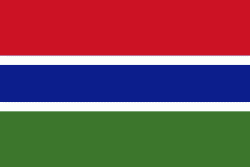Gambian dalasi
D
The dalasi is the currency of the Gambia that was adopted in 1971. It is subdivided into 100 bututs. It replaced the Gambian pound at a rate of 1 pound = 5 dalasis, i.e. 1 dalasi = 0.2 pound = 4 shillings.The derivative of dala is unknown. In numerous languages in the Francophonie, currency terms (including batut, dalasi, doromi, teemer) refer to the former 5 French West African franc note (the lowest denomination at the time), but to which the origins are not known. One speculated origin is a pronunciation of "dollar", however variants of dalasi in other Mandinka dialects such as daasi, counter this speculation while butut is from Wolof butuut, "small thing".
As a result of inflation, now bututs coins have completely disappeared from circulation and the minimum monetary unit has become 1 dalasi.
See also; Coins of the Gambian dalasi
In 1971, coins in denominations of 1, 5, 10, 25 and 50 bututs and 1 dalasi were introduced. The 1 and 5 bututs were struck in bronze while the 10 bututs were brass and the 25, 50 bututs and 1 dalasi were cupro-nickel. The reverse designs of the three higher denominations were taken from the corresponding denominations of the previous currency (1, 2 and 4 shillings), with the reverse designs for the lower three coins coming from the 6, 1 and 3 pence coins, respectively. All coins of this series depict former president, Sir Dawda Jawara.
Rounding methods for the butut were described in an article published in the 1986 issue of the recreational mathematical journal Eureka, in connection with Gambian mathematical education and its relation to counting coins; individual bututs were described as having no commercial significance, while other coins were colloquially referred to using old British nomenclature.
New 1 dalasi coins were introduced in 1987, modeled on the 50 pence coin of the United Kingdom. These replaced the larger, round dalasi coins which never saw its widespread use as the lower denominations.
In 1998, a new coin series was introduced, in which the effigy of Dawda Jawara was dropped and replaced with the national coat of arms on the obverses. However, older Jawara era coins still commonly circulate as legal tender. The 1 dalasi coin was also downsized in size and weight, but none of the other coins were changed. Only 25 and 50 bututs and 1 dalasi coins are currently in circulation, they are of the 1998 issue which also included 1, 5 and 10 bututs coins but have since disappeared due to their low value.
According to the situation for 2019, bututs coins have completely disappeared due to their low value, the minimum monetary unit has become 1 dalasi.
As of October 1, 2021, according to the Central Bank of the Gambia website ( https://www.cbg.gm/ ), the reference rate (value) of the dalasi was 48 per US dollar or about 2 cents US. All of their previous currency (notes and coins) is still legal to use. However the reduced value of the dalasi has made the 1b, 5b, and 10b coins of little use. The 25b (about half a cent) and 50b (about 1 cent) are of limited use as prices tend to be set in dalasi. The 1 dalasi coin is still in use to make change for the 5 dalasi (ten cents) banknote.
Country
-
The Gambia
The Gambia, officially the Republic of The Gambia, is a country in West Africa. It is the smallest country within mainland Africa and is surrounded by Senegal, except for its western coast on the Atlantic Ocean. The Gambia is situated on both sides of the lower reaches of the Gambia River, the nation's namesake, which flows through the centre of the Gambia and empties into the Atlantic Ocean, and elucidates the long shape of the country. It has an area of 11300 km² with a population of 1,857,181 as of the April 2013 census. Banjul is the Gambian capital and the country's largest metropolitan area, while the largest cities are Serekunda and Brikama.
The Portuguese in 1455 entered the Gambian region, the first Europeans to do so, but never established important trade there. In 1765, the Gambia was made a part of the British Empire by establishment of the Gambia. In 1965, the Gambia gained independence under the leadership of Dawda Jawara, who ruled until Yahya Jammeh seized power in a bloodless 1994 coup. Adama Barrow became the Gambia's third president in January 2017, after defeating Jammeh in the December 2016 elections. Jammeh initially accepted the results, before refusing to leave office, triggering a constitutional crisis and military intervention by the Economic Community of West African States that resulted in his removal two days after his term was initially scheduled to end.
